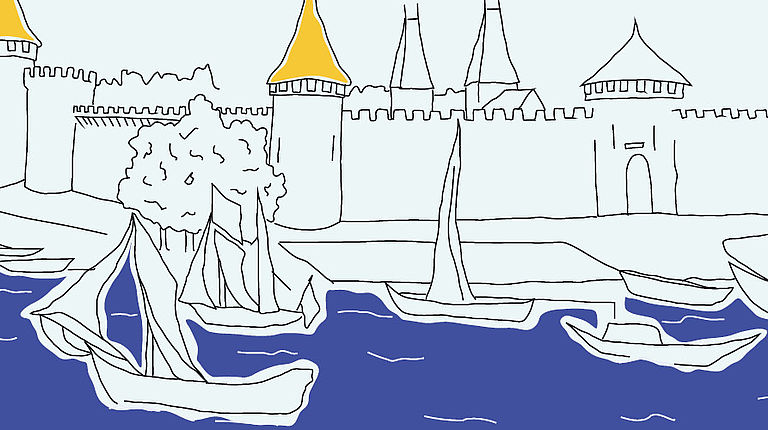Panel 4 : Maritime meeting point
Located about a hundred kilometres from the sea, the port of Libourne has the distinction of being both a river port served by two rivers, the Isle and the Dordogne, and also a sea port accessible to tall ships thanks to the effect of the tides and the channel dug in the bed of the rivers where they meet. The importance of this confluence called for an administrative organisation. This evolved over time, with diplomatic ramifications.
Administrative organisation
Initially, the jurats were responsible for policing the port. This included collecting customs duties or tolls on ferries crossing the rivers, applying policing measures such as preventing ballast being thrown from ships into the riverbed so as not to endanger the channels through which the boats passed, or sanitary measures and quarantines during epidemics.
At the start of the 16th century, the French monarchy set up an administrative organisation which gradually replaced the medieval systems. These involved the management of water and forests in rural areas, and admiralties for maritime areas. Admiralty jurisdiction was exercised over the coasts and their ports, as well as over the rivers in those parts of their course where the ebb tide was significant. At the time, these areas were considered to be seas, hence the term ‘entre deux mers’ (between two seas), which is still used to describe the Médoc.
The port of Libourne was under the authority of the Admiralty of Guyenne, whose headquarters had been in Bordeaux since 1490. This authority linked to maritime activity issued permits to enter and leave the port of Libourne, known as ‘congés’. As a result, ships had to go to Bordeaux before returning to Libourne. The installation of an Admiralty Registry on site in 1728 put an end to this significant diversion. Subsequently, the municipality of Libourne was deprived of all authority over the port by a decree issued by the Council of State in 1738.
The 18th century was a prosperous century for the town and its port, and this prosperity was further enhanced in 1756 when it was granted the right to trade freely with the Americas and thereby move beyond purely European trade relations.
International relations
As a result of the port's activity, many sailors and travellers, many from all over the Atlantic coast and northern Europe, passed through the port. This situation created a need for interpreters on the one hand, and the need for representation of the main nations using the port on the other. For example, Pierre Beylot received letters of marque in 1781 as Vice-Consul of the German Nation, the Netherlands and Flanders. These diplomatic posts remained in place in 19th century. It should be remembered that Paul Princeteau, father of the famous Libourne painter, counted being Vice-Consul of the Netherlands among his many public functions.
Between the 18th and 19th centuries, the importance of the Flemish community was underlined by the existence of the ‘allées flamandes’ (Flemish avenues) which was the name given at the time to what is today Quai d'Amade and Cours des Girondins.
Some of the port’s boats
Several different types of boat travelled along the rivers. The boat which is most associated with images of the ports along the Dordogne is the gabarre, a boat with sails used to transport goods.Its hull is rounded and it has a folding mast for passing under bridges. The gabarres mostly sailed to the lower valley of the Dordogne, downstream from Libourne, and were sometimes escorted by a gabarrot, a small barge which completed the transportation of a load.
The coureaux have the same sail and operating features as the gabarres, but have a flat bottom which allowed them to travel in shallow water. A small coureau is called a couralin.
Lastly, the argentat, a boat designed to transport firewood, only ever makes one trip. On arrival, once unloaded, it was dismantled and its own wood was in turn sold as firewood.
